So, you have just set up your brand new aquarium.
You spent hours aquascaping, ensuring the, substrate, plants, decorations and aquarium equipment are just right.
You finally add the water…
And all of a sudden…
Bubbles!
Bubbles everywhere!
Where did the bubbles come from and, more importantly, how do you get rid of them?
Well, today I am going to answer exactly that.
As it turns out, there is more than one cause for these annoying little bubbles.
Contents
Air bubbles caused by filling your new tank with water
Air bubble location: On the glass pane of your aquarium and decorations
If you have never set up an aquarium, then the bubbles that form on the glass of your aquarium will come as a surprise.
When you add tap water to your aquarium, pockets of air are trapped among the substrate, plants and decorations. As you slowly add more and more regular water, these air bubbles rise and cling to the glass of your aquarium.
If you use a jug or container to fill your aquarium, these bubbles often appear as lines, like in the picture above.
The reason for this is that each time you add clean water, the air bubbles rise to the surface, clinging to the glass.
As you add more aquarium water, the surface level raises and more air bubbles are trapped.
These newly trapped bubbles rise to the new surface level, leaving the previous bubbles at the old surface level – the result is evenly spaced lines of bubbles.
How to get rid of air bubbles stuck to the aquarium glass and decorations
Air bubbles that are produced by filling your tank for the first time are the easiest to get rid of. You don’t even need to do anything. Seriously!
Over the course of a week, these bubbles will gradually rise to the top of the tank water and pop on their own. If you have water flow movement, say from a air-driven filter, the bubbles will disappear much quicker.
Don’t want to wait?
You can take matters into your own hands. Literally! Simply rub the bubbles off with your hand or an algae scrubber.
Bubbles from your filter outlet
Air bubble location: Surface of the water
Another likely cause is your aquarium filter. Even if it doesn’t look like it.
You see, It can be tricky to determine if the cause of the bubbles on the water surface is from your filter. This is because the aquarium filter outlet is generating a current that pushes the air bubbles around your tank.
These bubbles will float around until they find a surface to cling to. This could be the aquarium glass, a branch sticking out of the water column, the top of the aquarium plant or even the entire filter itself.
Look closely at where your hanging filter outlet enters the water. Even if your filter is only producing a single bubble every few seconds, it is more than enough for bubbles start to build up.
Below are bubbles that were made by a filter flow that floated around the tank until they attached to a aquarium plant that is sticking out of the water.
Don’t be fooled! Just because the bubbles are attached to the plant does not mean that the plant is producing them.
How to stop your filter from producing bubbles
Unless you have a faulty filter, the filter unit isn’t responsible for these small bubbles. You’ll likely find that your filter outlet, the part of the filter that returns the water to your saltwater tank, is to blame.
If your outlet sits above the water, the stream of water that flows down into your tank can trap air, pushing it under water and producing the small bubbles floating around your tank.
So, what you want to do is minimize the amount of contact this stream of water has with the air.
The easiest way to do this is to reposition the filter outlet on or just below the water surface so that no air becomes trapped.
Can’t lower the filter outlet any farther? Then bring the water to the outlet. Simply add more water to your aquarium until the water level is in line with your filter outlet.
Bubbles from your heater
Air bubble location: On or near your aquarium heater
Here is something you might not know:
Cold water is capable of holding more oxygen than warm water.
If cold water suddenly becomes warmer, that oxygen has to go somewhere. So, it leaves the water and forms air bubbles.
If you just turned on your aquarium heater for the first time, don’t be surprised if air bubbles form as oxygen because it has nowhere else to go.
The good news is that once your water reaches the preset water temperature, no more bubbles will form. Well, until…
Air bubbles appearing during a water change
Air bubble location: Micro bubbles all over the glass and other surfaces of the tank
As I briefly covered earlier, cold water holds more oxygen than hot water. And, rapid changes in warm temperature can cause the oxygen to leave the water in the form of bubbles.
Guess what happens when you add cold water to the warm water in your tropical fish tank during an unclean water change?
That’s right, bubbles. And lots of them. Fine excessive bubbles will cover the glass and other surfaces in your aquarium.
Fortunately, these bubbles quickly disappear on their own. If you want to avoid the bubbles in water entirely, heat the fresh water so that it is closer to the temperature of your aquarium before adding it.
Bubbles on plants
Air bubble location: On the surface of plants or rising from plants
Think back to high school, and you might remember that plants produce oxygen through a process known as photosynthesis.
If the dechlorinated water in your aquarium is low on oxygen, then the oxygen will just “merge” with the water. You cannot see this process.
But if your water is already full of oxygen, then the oxygen that the plants produce need to go somewhere else. So instead, bubbles form that slowly float to the surface.
In this short video, you see bubbles rising from a plant.
Pearling can also happen if you cut your plants. Let’s say you cut away a dead leaf, or your fish take a bite out of a stem. Micro bubbles can “leak” out from the cut in the plant. This will eventually stop on its own and will not harm your plant.
Oh, algae is a plant too. And you know what that means….
It can also pearl. Check it out:
So if you have an algae outbreak, then those bubbles covering every surface of your aquarium might be the algae pearling.
Speaking of algae…
Bubbles from dead algae
If you returned home to find your tank overrun with algae, chances are that you reached for a bottle of Algaefix, one of the more popular products that can stop algae in its tracks.
But all that dead algae brings with it a new problem –excess ammonia.
If you think back to the nitrogen cycle, you are aware that ammonia isn’t something you want in your tank.
If you see bubbles forming on top of dead algae, then these are likely ammonia bubbles. Your best solution, at this point, is to remove as much of the dead algae as possible.
Repeated water changes, a good water conditioner and monitoring the aquarium closely with a good test kit, will help you win this battle.
Bubble nests made by fish
Air bubble location: Surface of the water
Exhausted this entire list and still can’t find the cause of the bubbles in your aquarium? It may actually be your fish at fault.
If you have one of the following fish…
- Betta
- Gourami
- Catfish
…then these clusters of bubbles that are floating on top of the water could actually be a bubble nest.
You see, in the wild, these bubble nests would have babies in them and come naturally to the fish listed above. In fact, if a fish is building a bubble nest, then it is a good sign that it’s healthy.
But unless you plan on breeding your fish, these bubble nester doesn’t really serve a purpose. If you see your fish building a nest, no problem! Let them enjoy the activity – until the next time you clean your aquarium.
Conclusion
As you see, there are many different triggers that cause bubbles to appear! But with a bit of investigation, you can figure out the mystery behind the small bubbles appearing in your aquarium.
What was the cause of bubbles in your aquarium? Let me know in the comments below!

Ian Sterling, founder of Fishlab.com, began his aquarium journey over 30 years ago, driven by a deep fascination for fish and their diverse personalities. His website, Fishlab.com, is dedicated to making fishkeeping accessible and enjoyable, offering beginner-friendly guidance, expert insights, and a community for aquarists to connect and share experiences.


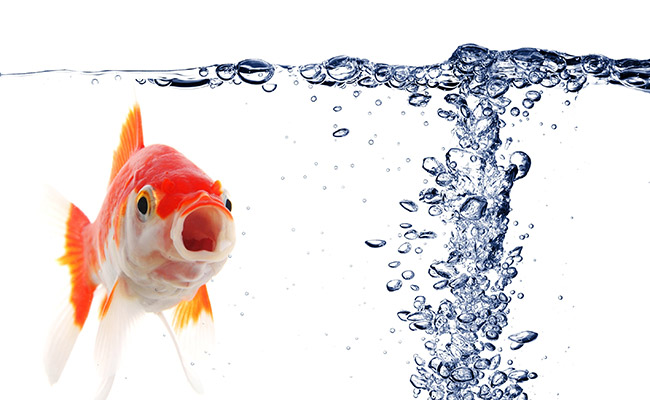
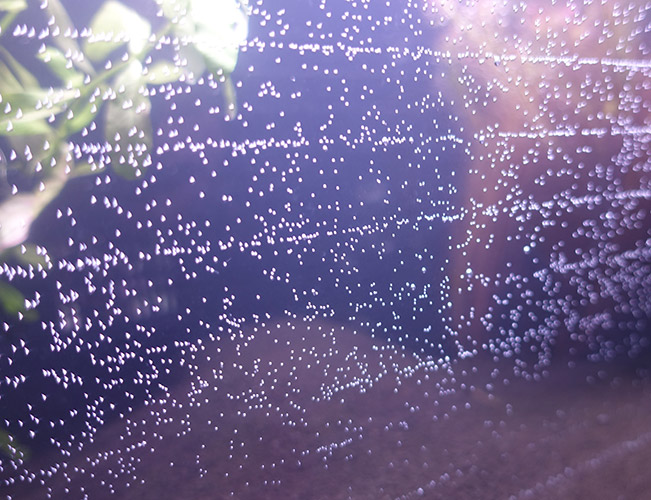


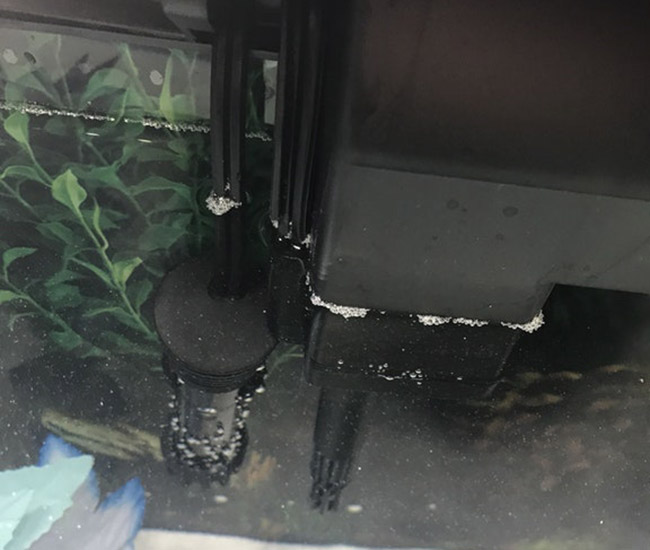

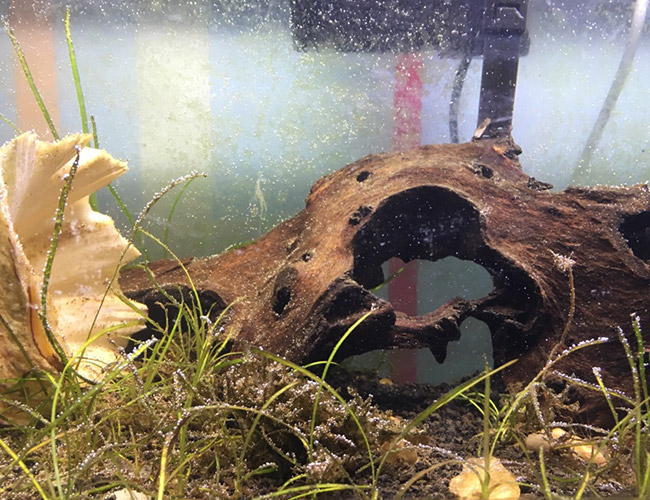
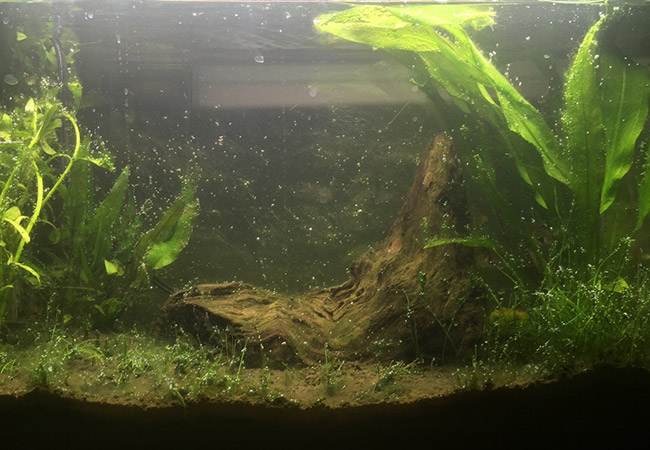
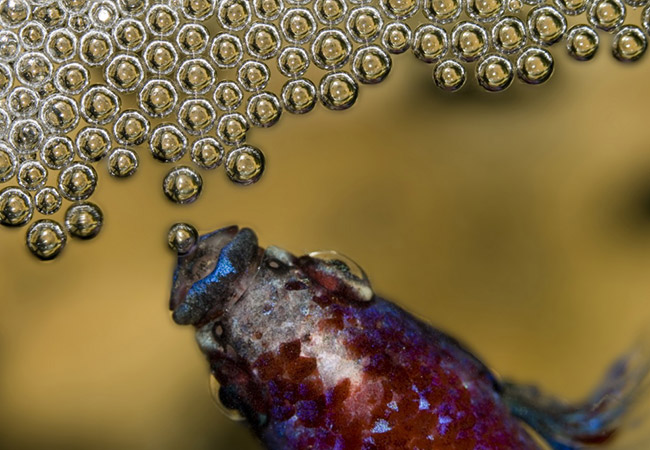
Comments (46)
I have pair of gouramis but I don’t know the gender. One day one of my gourami making bubbles on the tank edges (like corner front to back). And the next day they are dead. I am very sad and want to know the reason for their deaths.
Hi Seetha,
I’m sorry to hear about your loss. There could be any number of reasons why your fish passed on. Check out this guide, it covers many of the common reasons fish suddenly die.
I recently adopted a Betta & I’m new to the fish world. I purchased a 5-gallon tank for my new biz and followed ALL of the instructions I received from various Betta sites (this girl likes HAPPY pets!) ..including rinsing everything with warm water (no soap!), using distilled water and a water conditioner and allowing the tank to run for 24-hours before introducing ‘fishy’ to the tank. He’s doing GREAT! He’s been in his tank since July 2nd appears to be doing great! Tank looks great and Sebastian is happy! I see him everyday but when I went in today I noticed random little bubbles on the surface and it wasn’t a bubble nest. Just little bubbles here and there. I don’t have any live plants except for the green ‘fluff ball’ Bettas love (can’t remember the name of it). I haven’t had my hand in his tank but I did put in a ping pong ball I rinsed for a couple of days..he wasn’t interested so I removed it (without touching the water). Just want to keep him healthy. Any idea why I have these odd bubbles? Thank you SO much!
Hi Sebastian,
Firstly, congratulations on trying to keep your Betta happy and healthy!
Since the tank has only recently been set up, these could just be stray air bubbles that got trapped underwater and have slowly been making their way to the surface – it’s not uncommon on new setups.
If this is the case, these will gradually disappear on their own and are nothing to worry about.
On a side note: 24 hours typically isn’t long enough to cycle an aquarium. You should buy yourself a good aquarium aquarium test kit, to make sure that your fish isn’t swimming in toxic water. Check out our aquarium cycling guide for more information.
Today I changed foods for my Oscar I have a 8inch long Oscar and a 10 inch long algae eater. I just started noticing a bunch of bubbles in my aquarium I have a 45-gallon filter and I have a 29 gallon tank. I want to know if these bubbles could be lethal or unharmful
Hi Tim,
Go through this guide and see if any of these are the cause of your bubble problem. If it’s just trapped air, then these bubbles are harmless.
You have a Oscar in a 29 gallon tank?
I do regular water changes, however, I noticed large bubbles coming from the sand/substrate at the bottom of my tank. Is there any need for concern?
Hi Leigh,
Thanks for your great question, it’s one that I will have to cover in this guide when I get time to update it.
Bubbles coming from your sand could be air that has been trapped when you originally added the sand to your tank.
Alternatively, it could be nitrogen gas, which is naturally given off by anaerobic bacteria living deep in the sand – the same bacteria that live deep inside filter media like ceramic rings This is typical if you have a deeper sand bed (deeper than 1 inch) and do not regularly stir your sand.
These gasses are “lighter” than water and as they build up, or get disturbed, will push through the sand bed, making it look like your sand is bubbling.
I suggest reading up on sand substrate maintenance, as in extreme cases, the gases given off from the substrate can kill your fish. However, typically they should just bubble away harmlessly.
i recently purchased a couple of fresh water snails in my 2 gallon acquarium. They are doing great but the tank smells horrible. Ive cleaned the tank thoroughly and it starts to smelll again within a day. Any recommendations?
Hi Brandi,
Have you checked out my guide to fixing bad odors in the aquarium? You might find the answer there.
Are 14 male betta tanks too many?? They are so beautiful and there lots of different colors and types.
Hi Rose,
A single Betta should ideally be kept in a 5 gallon tank. If you tanks are say 1 gallon, then yeah, it’s better to keep fewer betta in separate larger tanks.
1 male for 15 gallon tank m8….
Depends on personality aswell, don’t you dare put 2 together aswell, it will stress them out even if they don’t fight…
Hi Youssef,
I agree with you, but 5 gallon is the minimum acceptable size. I doubt you’ll find any beginner buy a 15 gallon for a single betta. While I would love for all bettas to live in 15 gallon tanks, the reality is that’s not going to happen. I’m sure you’ll agree that it’s better they sit in a 5 gallon than a 1 gallon.
This debate on “ideal better tank size” has gone on forever. I have no intention re-igniting it here. The general consensus among betta communities is that 5 gallon is the bare minimum. I share these thoughts.
Thanks weighing in on the discussion.
Hi Ian,
I recently got a betta and tank, and am currently (due to ignorance) attempting a fish-in cycle with him. I have the following:
API quick start, and stress coat
Aqueon betta bowl water conditioner
Seachem prime and pristine coming by Friday
I have API test kits (liquid drops) for Ammonia and pH, and have Nitrite, Nitrate, and GH & KH coming by Friday. I believe the ammonia is starting to build to the 0.25ppm stage- which is why I bought Seachem prime (i read you article about fish-in cycling). I change about 30% of water every 2 days or so.
My question is, I notice large bubbles that float randomly across the whole water surface. Not small enough to be a bubble nest. They are coming from my betta’s mouth as I have seem him blow them. Are they due to any difficulty in breathing? Are they any indication of distress due to water conditions?
Thank you
Hi Alex,
Well done for identifying you need to cycle your tank. You can replace the stress coat and betta bowl water conditioner and in a proper tank setup, there really is no need for pristine. This will make keeping your betta much cheaper (these products soon add up) and generally speaking,t he less chemicals you use, the better.
That said, it sounds like you are on top of this and doing all you can. If you can keep the ammonia down at 0.25 with water changes, you’ll be on your way before long. My only advice would be that rather that remove a constant 30%, adjust this if needed according to your test kit. Lets say your ammonia reaches 0.5 ppm, it will need a 50% change to get it back to 0.25 ppm, as it roughly halves the amount in the water.
Onto your question, this can be perfectly normal and isn’t necessarily a sign of stress. I have seen two other betta do this that were otherwise perfectly healthy, it was a habit for them. Interestingly, after a year, one of the betta stopped this behavior entirely while the other did it until it passed (but it lived a long and happy life)
At this stage all you can do is keep an eye on those water parameters and react accordingly.
I’ve been having major issues with cloudy water. First, I thought my tank wasnt cycling. Then I thought it was a bacteria bloom. Now, im starting to think its micro bubbles. I had ceramic bio filter “beads” in the filter along with the filter bag. I took the bio filters out, just waiting to see if that helps my tank clear up. I have a decent amount of plants (10 gallon tank). I also cut them about three weeks ago. Is it possible to have too many plants? And if it is micro bubbles, how can i help clear them out?
Thanks in advance!
Hi Melissa,
The ceramic beads are where the beneficial bacteria live. You don’t want to get rid of these as they essentially keep your aquarium in balance. I highly recommend buying a test kit (The API Master Test Kit has everything you need) and test your ammonia, nitrite and nitrate – I am concerned you have crashed your cycle. You should already have a test kit if you plan on keeping fish long term. These test kits can be used to identify the majority of problems a tank will face.
As for the “bubbles” are you sure it’s not tiny sediment being blown around your tank? Take some water, place it in a coffee filter to find out. If there is sediment left behind, then that’s what it is.
If it’s micro bubbles, and it’s a new tank, these will eventually go away on their own, unless something is generating them. The only way to know for sure is to wait it out. It’s also possible your filter is sucking in air with the water if the inflow is too high.
Hi just set up my first tank 60 lyre. No fish yet I’m waiting for water to settle down and treated etc. but a lot of bubbles on side of tank. Using a ciao filter
Hi Robert,
Not a lot of information to go off here but it’s possibly just bubbles settling from when you first set up your tank. If so, they will go in time.
I set up my tank with 2 inches of gravel substrate (1-2 mm size). I found that there are a lot of air pockets in the aquarium (while moving some gravel).
I am not sure, whether the air packets will remove themselves (since the gravel size is small). Do I have to remove them myself at any point? What happens if they stay there for a long time?
Hi Al,
If the gravel is not too compacted, the air pockets should go on their own. However, I would recommend using a chopstick or something similar to give the gravel a stir. Go slow so you don’t kick up too much gunk and silt into the water. Although don’t worry if you do, your filter will trap a lot of it and the rest will eventually settle.
This will release any trapped air pockets under the surface. I have never come across issues air pockets being trapped under gravel – they don’t remain trapped for too long. However, in sand tanks it can cause to problems once the air is finally released, but that shouldn’t be relevant here.
hi Ian,
is this gas harmful to shrimp ?
Hi Chong,
Good question, Unfortunately, I have no experience with built up nitrogen gas as I stir my sand beds regularly. If it displaced oxygen, then it would certainly be harmful, but I don’t think shrimp would go out of their way to feed on it otherwise.
I set up my new aquarium like 5 days ago. Like 8 cm of gravel, lots of plants and rocks. And now there a bubbles coming from under my spiderwood(like every 10 seconds). So a lot of floating bubbles on the surface. Is this normal? (their are rocks on the spiderwood to keep it down). Oh and there is groing white gunk on the spiderwood. I read thats no problem, but maybe they are making the bubbles.
Hi Chris,
It’s possibly air trapped inside the spiderwood (this is why you have to weigh it down) often people boil their wood first to waterlog it. That clear film you see on the outside of the wood is to be expected and harmless. It’s still early days, if I was in your position, I wouldn’t even look for the cause unless they were there in another few weeks.
Tx Ian!
Hi I have just set up a small 60ltr hexagon shape tank , when I bought it , it came with many extras one been a air curtain thank runs the length of some underwater leds given off a good effect , however the bubbles run half way round the back of the tank and when the bubbles rise some are sucked in through the filter and then come out the top as millions of smaller bubbles causing a lot of tiny bubbles to go round the tank . Will this eventually stop as the water matures or do I need to move the filter which I don’t really want to as it would then have to be moved to the front of the tank not looking so good
Hi Mark,
If you turn the air curtain off, do the bubbles tiny bubbles coming out the filter disappear? If so, this won’t stop unless you fix the cause of the bubbles. Are you able to block the holes on the filter side?
Hey I bought a new tank 1 week ago. And then I bought an Air pump, but when I turned on the pump, there are lots of air bubbles float on the water. The bubbles disappeared when I turn off the pump. I don’t think that’s good. What should I do?
Hi Gavin,
Try swapping out the airstone connected on the other end? Bubbles floating on the water, from an air pump, are not a problem and won’t harm your fish.
I have just noticed my three fish are dead and the tropical tank is full of bubbles. it looks like washing up liquid bubbles. i have taken the air filter out and cleaned it and the foam inside smelled like bleach. what could have caused this. Do i need a new filter
Hi Norma,
Unfortunately, without testing, it’s difficult to say. What does your aquarium test kit reveal? These numbers should clue you in as to what is happening in your tank. If you don’t have one, I highly recommend the API master test kit, it has everything you need.
The fish in the main article image seems to be in great distress. Is your fish okay? Does it need our assistance? We are very concerned about the mental well-being of your fish. Fish health is of the utmost importance to us and we are only here to help. Fish play a great roll in the world and we are trying our hardest to make sure all fish are happy and living their best. Please contact me in regards to the state of your fish hoping that he/she is okay.
Sincerely, Lizzyb & Montero the Man.
Thank you!
Hi Lizzyb & Montero the Man,
The fish in that photo is fine. He was photoshopped. He’s making that face as he eats.
I just recently started seeing silver almost Mercury like bubbles on the bottom of my suction cup to my 40 gallon aquarium heater I’m not sure if that’s Mercury or if it’s just oxygen that looks like Pearl but that’s the only spot besides one plant I saw and also a cluster of small bubbles together hanging off the plant could it be my heater glass cracked those shiny bubbles & what should I do
Hi Christopher,
The good news is that those bubbles in your tank certainly shouldn’t be mercury. And a visual inspection of your heater should confirm it isn’t cracked. It’s likely just trapped air, perhaps from a water change or sticking a net in the tank?
Hello,
I had a dead glow fish in my 10 gal tank, so change the water last night and this morning there were foamy bubbles. Should i do another water change today? How often can i do water changes?
Thank you
Hi Lesly,
There isn’t really a hard limit on how many water changes you can do. If your tank has cycled (check your test kit) then you can do as many as you want. However, given that they require effort to perform, most people only do it once a week for a healthy tank.
I recently set up a 55 gal fresh water with 2 inches of organic potting soil and one inch of pool filter sand. I let it cycle full for a month before adding fish. I change 25% of the water weekly because the driftwood continues to discolor the water. I have added fish now and am losing them daily. The water tests are all ok yet I continue to lose fish. There are occasional large bubbles rising out of the medium. Are these bubbles the cause of the fatalities. The organic potting soil may be the culprit. How do I resolve this problem?
Hi Karl,
what does your aquarium test kit say? Cycling can take longer than a month and the test kit will provide clues as to what is happening in your tank.
What are the results of your:
Ph
Ammonia
Nitrite
Nitrate
This article was definitely a good read. I cleaned my beta tank and have all of these bubbles. Based on your article, I am not stressing right now. As I was scrolling through the comments, you mentioned that a beta should be at minimum in a 5 gallon tank. I purchased a Marina Betta EZ Aquarium. It is only .7 gallons. Why would one betta need a larger tank?
Hi Angela,
Excellent question. Unfortunately, .7 gallons is far too small for a betta. I cover this in detail here:
https://fishlab.com/betta-fish-tank-size/
Wow!!! NO ONE at Petco told me this. Oh brother! This was a good article. Thank you for taking the time to reply to my question. Guess, I need to toss the .7 gallon and invest in at least a 5 gallon tank.
Hi Angela,
Unfortunately, many people learn this the hard way. Petco, Petsmart and other bigbox chains do not provide beginners with the essential information needed to keep fish happy and healthy. If you have a local fish store that only sells fish, that is a much better source of information since these people keep fish themselves and love to help newcommers to the hobby. Also, If they didn’t tell you about that, then it’s likely they also didn’t tell you about the nitrogen cycle and testing your aquarium?
If they didn’t, this page should get you up to speed:
https://fishlab.com/how-to-cycle-aquarium/
I would argue that this is the most important part of keeping an aquarium. It seems complicated, but once you get an understanding, it will allow your fish to live their life-span, which as a pet owner is what we all want.
I’m happy to answer any questions you have on this process in the comments on that page (keeps everything related to the topic in one space)